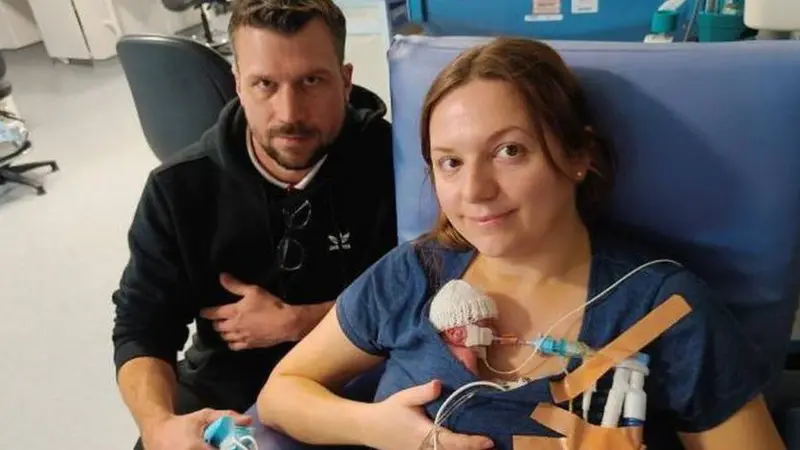
The parents of a baby named Robyn, who was born very tiny at just 11 ounces (328 grams), have finally brought her home after 18 months in the hospital.
Robyn was born five months early in March 2023 at Grange Hospital in Cwmbran, Torfaen, and she still needs special care all the time. Her parents, Chantelle (34) and Daniel (38) from Malpas, Newport, are raising money for her treatment. Chantelle said, “It’s like a dream come true to have Robyn home.”
Robyn was born at just 23 weeks and 2 days and was so tiny that she could fit in the palm of a hand. To keep her organs warm while she grew, she was kept in a sandwich bag.
After six months in the hospital, she spent another seven months in the pediatric intensive care unit at Noah’s Ark Children’s Hospital in Cardiff. She then returned to Grange Hospital until she was finally discharged in September.
Chantelle, who works part-time as an accountant, said, “It’s just so nice to do normal family things… and just all be together under one roof.”
Daniel, a self-employed bricklayer, mentioned that it’s much less chaotic at home now. He has had to cut back on work to focus on taking care of his daughter.

Robyn gets oxygen and nutrition through tubes in her nose and mouth, and her vital signs are watched all the time. She takes 30 doses of medication each day.
Her mom, Chantelle, explained, “She can’t cough, so we have to suction her mouth and nose throughout the day when she needs it.”
Daniel described Robyn as doing well and enjoying the “peace” of being at home. He added that they do a lot of physical therapy and play with her to help her senses.

Chantelle said it was tough to bond with Robyn in the busy hospital ward, with doctors and nurses always coming in and out.
“All you can do is sit next to her and watch,” she explained, “keeping an eye on the numbers on the screen and hoping she will be okay.”
“When Robyn was born, we weren’t sure if she would survive.
“As time went on, she grew bigger and stronger, but she still faced many problems. It became clear that her brain damage would have a big impact on her.”
‘We know nothing is impossible’
“We didn’t learn about her brain damage until about six months after she was born,” Daniel said.
“You have all these plans for how life will be, and then everything changes,” he added.
“But we try to stay positive.
“We know that nothing is impossible for Robyn because she has been told so many times that she wouldn’t be able to do things or even survive, but she keeps proving everyone wrong.
“She’s full of surprises, and I believe she will create her own story.”
10 Sweet Stories of People Who Deserve a «Parent of the Year» Award
It’s heartwarming to hear about people who have amazing parents who support them with love and laughter, even as they grow older. Their stories can really touch your heart and make you appreciate your own loved ones even more.

- Mom noticed Dad had red lipstick on his collar, but she didn’t confront him about it. A few days later, I discovered the foundation on his hand, which infuriated me. I confronted my dad, causing a big scene. He confessed that he was taking makeup classes, which only made my mom angrier.
However, my dad proved he wasn’t cheating; he had been practicing makeup on himself. He demonstrated his skills, showing how well he could do it. He explained that with two daughters, one grown and one young, and another on the way, he wanted to be a good dad who could do anything for them.
- At the age of 17, I suddenly realized that I didn’t fit the conventional standards of beauty among my peers. I faced ridicule for being red-haired, petite, and freckled. To hide my insecurities, I started covering my freckles with foundation, dyed my hair dark, and wore ill-fitting clothes. My dad noticed this change and gently probed to understand the reason behind it.
Eventually, I broke down, cried, and poured out my heart to him. In response, he simply said, «So what if you’re petite, with short legs, and red-haired? These are just features! Look at how cute you are! Embrace who you are.» His words struck a chord within me, and I finally began to accept and love myself for who I am.

- I stumbled upon a mysterious note tucked inside Dad’s wallet one day. Intrigued, I decided to investigate further. Days later, while rummaging through Dad’s briefcase, I discovered a hidden compartment containing another note and a small trinket. Confused and curious, I confronted Dad, demanding an explanation for these clandestine discoveries.
To my surprise, Dad confessed that he had been leaving secret love notes and tokens of affection around the house for Mom as a romantic gesture. Initially taken aback, I couldn’t help but feel touched by Dad’s thoughtfulness and creativity. Witnessing this sweet gesture between my parents sparked a newfound appreciation for the depth of their love, showing me the power of small surprises in keeping the spark alive in a relationship.
- Father returned from work, his expression serious as he approached my mom and me. He began, «Do you know who I just saw?!» We waited in anticipation as he continued, «I was walking in the dark, with only one lantern shining, when suddenly, a huge hare jumped out!» Mom and I exchanged surprised glances, only for Dad to pull out a large chocolate bar, saying, «So this bunny asked me to give you a chocolate bar!» Despite being 24 years old, I still fall for this joke about the bunny, as if I were still 6!

- After finishing school, I accompanied my mother to enroll in university. I passed the exams and was accepted, with my mother’s help in securing a dorm room. Late in the evening, my mom left, leaving me with all the money except for enough for her ticket back home. Excited to start this new chapter of independence, I eagerly joined new friends for a night of celebration.
What I didn’t know was that my mother missed the last bus and spent the entire night at the station, with only enough money for a ticket and a simple meal of tea and cookies. It wasn’t until 7 years later that I learned about her sacrifice, and I cried uncontrollably upon realizing her selflessness.
- During a family camping trip, I mentioned how much I’d love to try fishing. Despite not being huge fans of fishing themselves, my parents set up all the gear and patiently showed me how to cast a line. Throughout the day, I struggled to catch anything, but they kept cheering me on with big smiles.
Finally, I caught my first fish—a tiny trout—and their excitement was contagious. It wasn’t until much later that I realized they had given up their fun to make sure I had a chance to try fishing. Their selfless gesture showed me just how much they cared, leaving a lasting impression on my heart.

- A week before my wedding, I discovered that my fiancé was cheating on me. Heartbroken, I turned to my mother for advice. While she sympathized with me, she urged me not to cancel the wedding. She reasoned that since everything was paid for, and I’d feel ashamed in front of relatives, it was best to go through with it for now, and later I could seek revenge and find peace. Reluctantly, I agreed.
However, my wedding day turned out to be the worst day of my life. Just before the ceremony, my dad noticed my distress and pulled me aside for a chat. I broke down and confessed everything to him. Instead of scolding me, he hugged me tightly and said, «Your happiness is what matters most. We’ll handle this together.» With his support, I confronted my cheating fiancé, expressed my true feelings, and walked away with my dignity intact. As we left, my dad proudly said, «That’s my girl!» and added a few words of affection.
- I remember my dad always getting really excited about very cheap, mundane foods like plain puffed rice cereal, bologna sandwiches, and unflavored steel-cut oats. He would get us all amped up about it, and we would want to eat it instead of the more expensive stuff we really wanted because of how much he talked it up. Now that I am older (and as a father myself), I don’t think he actually loved all these things that much. Instead, my parents just didn’t have the money to buy all that expensive food to feed three growing boys. © Rebelsoul3480 / Reddit

- A friend’s 14-year-old daughter boldly requested money for a tattoo—right on her face. While her mom resorted to calming herbal drinks, the father and daughter engaged in a serious discussion about the matter. Eventually, they agreed to visit a tattoo artist over the weekend. «I’ll pay double,» declared the father, «but first, you’ll feel the needle without any ink.»
During the appointment, the father discreetly instructed the artist to make the process as painful as possible. As the heart design began to take shape on her cheek, the daughter howled in agony—it hurt a lot. Despite the pain, they returned home that evening, all satisfied. It seems the father’s approach maintained a positive relationship with his daughter; after all, a stubborn refusal might have only led to more defiance.
- I went to visit my parents, feeling tired and overwhelmed with problems from all sides—work, friends, and personal issues. My mom and dad immediately sensed my mood and set out to cheer me up. They made my favorite comfort foods: cutlets with mashed potatoes and cake with tea.
Then, my father surprised me by borrowing a sled from a neighbor and taking me for a ride. For a couple of hours, all my worries melted away, and I felt like a child again—carefree and joyful. In those precious moments, I realized that no matter how old I am, I will always be my dad’s little daughter in his eyes.
We recommend reading a story of a woman who tried to warn her sister about her new boyfriend, but unfortunately, her sister didn’t take her advice. Now, she’s going through a tough divorce.
Preview photo credit jcomp / Freepik



Leave a Reply